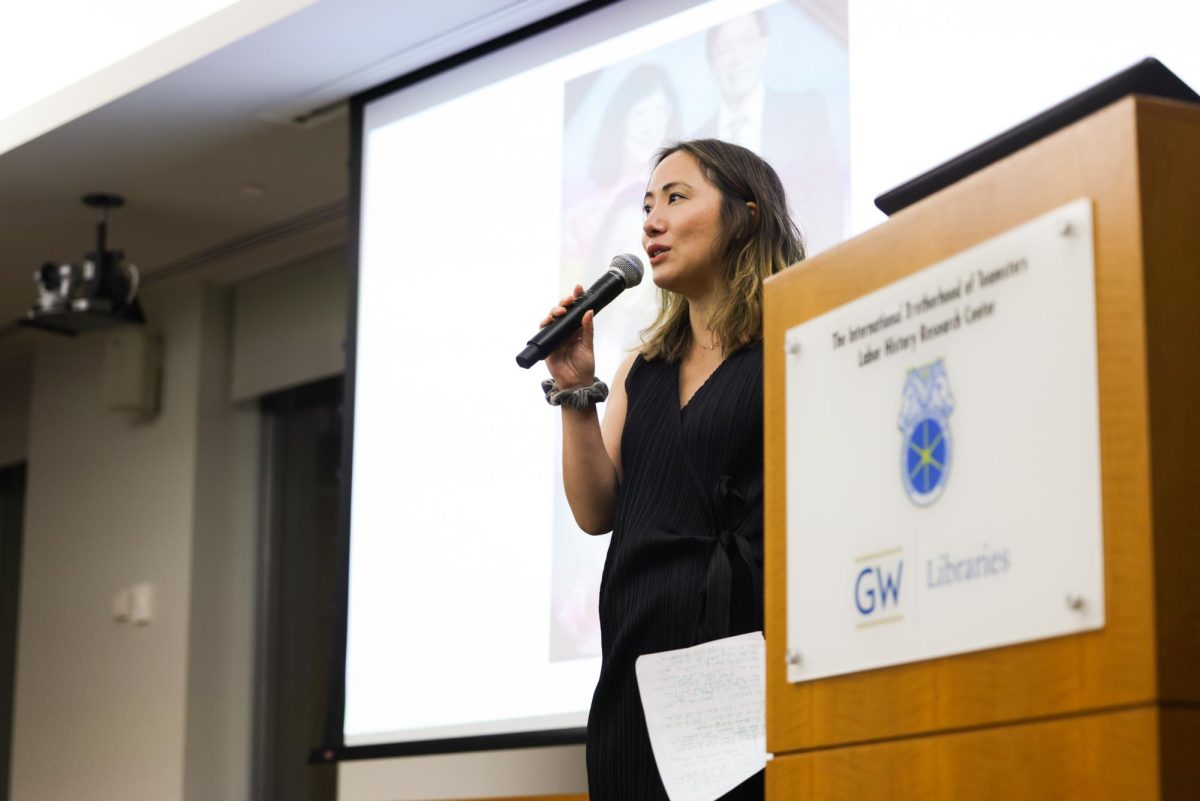Thirty students huddled Tuesday on the top floor of Duques Hall, eagerly awaiting a history lesson that only GW has been able to offer.
Federal Reserve Chairman Ben Bernanke led the hand-selected class of undergraduate students through a four-century overview of central banking both in the U.S. and around the world, marking his first of four lectures at GW.
Bernanke spoke for nearly an hour as part of the class titled, “Reflections on the Federal Reserve and Its Place in Today’s Economy,” before taking four student questions. He also expressed excitement in reading the students’ upcoming papers.
In the sixth-floor classroom, onlookers made up of the media, faculty and a UPD officer noticeably outnumbered the undergraduate students who, junior David Pomeroy explained, were well-briefed on both the media and security aspects of the class.
“I didn’t expect it to be a normal Tuesday,” Pomeroy said.
A dog from the K-9 unit sniffed students’ bags before they entered, marking their final barrier to entry and adding a pre-class routine atypical of the other GW School of Business classes. Back in late January, students first had to apply for a spot in the class by submitting a resume and a one-page letter detailing why they are interested in the Federal Reserve.
The class is led by professor Tim Fort who said after Chariman Bernanke’s first class that he thought it went very well, calling the lecture fun. Fort said Bernanke will read a selection of students’ papers that he deems to be the best in the class.
In his first lecture, Bernanke stuck closely to the text printed on his 49-slide PowerPoint presentation, explaining the role central banks play in the economy, the origin of central banks globally dating back to the 1600s and the evolution of the Federal Reserve within the United States.
“One thing people don’t appreciate, I think, is that central banking is not a new development,” Bernanke said. “It’s been around for a very long time.”
He noted Sweden set up a central bank in 1668, and that the Bank of England was founded several years later in 1694, calling it “the most important and influential central bank in the world” for the several decades, if not centuries, that followed.
Starting with the fundamentals of central banks, Bernanke went on to explain that a nation’s central bank serves two purposes – to provide macroeconomic stability by striving for stable inflation and stable growth while also ensuring the country’s financial stability by preventing or mitigating financial crises and panics.
“Financial stability concerns were a major reason why Congress decided to try to create a central bank in the beginning of the 20th century,” Bernanke said.
He also explained the shift from a gold standard adopted in the 19th century, tying the value of a dollar to the price of gold, calling it “at least a partial alternative to a central bank.”
Bernanke, not a supporter of a return to the gold standard, explained what he sees as significant problems with the monetary system. He called it an “an awful big waste of resources.”
“What you have to do to have a gold standard is you have to go to South Africa or someplace and dig up tons of gold and move it to New York and put it in the basement of the central bank in New York,” Bernanke said.
He called it a lot of effort and work to dig up gold in one place and “put it right bank in another hole,” which triggered laughs from around the room.
Senior Framroz Bankwalla says he has extensively studied issues surrounding central banking and economics, but felt this lecture offered something never before available to him at GW, calling the insider look an “eye-opener.”
“When you take a history class, it’s about history. When you take a finance course, it’s about finance. When you take a public policy course, it’s about public policy. But here, he brought it all together,” Bankwalla said.
Bankwalla referred to the unusual history lesson as offering practical, expert insight not typical textbook knowledge.
“Halfway through the class I forgot I was being lectured by the chairman of the Federal Reserve.” Bankwalla said. “He is very much a teacher in that sense.”
Senior Andres Martinez said he, like Bankwalla, also took the class to gain an “insider’s view” to the Federal Reserve System and glean an expert’s perspective, entering the classroom with an open mind already well oriented with financial policy.
“I thought he was very well spoken and calm the whole time,” Martinez said. “It made us, as students, very calm. He was kind of like another professor. I forgot he was chairman of the Federal Reserve after 15 minutes.”
While his lecture on GW’s campus was a first, Bernanke has lectured on college campuses many times before. He has over 20 years of experience teaching at Princeton University, Stanford University and New York University. He was a tenured professor at Princeton and chair of the Department of Economics from 1996 to 2002 before going into public service.
Bernanke will meet with the class three more times, on March 22, 27 and 29 to discuss central banking in a post-World War II economy, the most recent financial crisis and post-crisis regulation and the Federal Reserve’s response, amongst other related topics.





